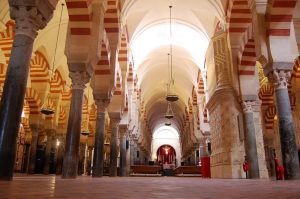The “Mezquita-Catedral”, or “The Mosque”, as we simply call it in Cordoba, has always held a special meaning for my family and me. My grandfather used to take me to “The Mosque” when I was just two years old. We would go to the “Courtyard of the Orange Trees”, where we would sit under the sun and listen to the murmur of the water gurgling along irrigation canals, overwhelmed by the fragance of the myriad jasmine flowers blooming around us. More visits followed throughout my childhood. My aunt and uncle lived in a house right by “The Mosque” and my cousins and I would go to the site to play and watch the tourists come and go. I would also be taken there by our teachers while in high school or attend mass with my familiy on Christmas Eve. I would accompany family visitors on their occasional tour and I would even go to the Courtyard of the Orange Trees to read a novel whenever classes in college got boring. In fact, I was even baptized in the Chapel of the Holy Shrine, one of the best-known chapels of “The Mosque”, where my parents had got married thirty years earlier!
 The first time I heard of the current controversy surrounding the history of “The Mosque” and the dispute over its use, I felt a tinge of sadness. It had never occurred to me that a place so close to my heart could fuel confrontation and mistrust. We had been taught in school how impressed Fernando III, “the Saint”, was when he took over Cordoba in 1236. The King decided to preserve the Muslim site in its entirety (the Cathedral inside was built later on, during the XVI century). We all knew the story of its construction, from Abdel Rahman I to Al Mansur. We all had heard of the elephants used to carry columns from ancient Roman temples, and admired the golden verses of the Quran on the walls of the Mihrab, a richly decorated niche where believers used to line up for prayer. To most of us, “The Mosque” was rather a very special place to enjoy quietness and tranquility rather than the subject of an endless theological debate.
The first time I heard of the current controversy surrounding the history of “The Mosque” and the dispute over its use, I felt a tinge of sadness. It had never occurred to me that a place so close to my heart could fuel confrontation and mistrust. We had been taught in school how impressed Fernando III, “the Saint”, was when he took over Cordoba in 1236. The King decided to preserve the Muslim site in its entirety (the Cathedral inside was built later on, during the XVI century). We all knew the story of its construction, from Abdel Rahman I to Al Mansur. We all had heard of the elephants used to carry columns from ancient Roman temples, and admired the golden verses of the Quran on the walls of the Mihrab, a richly decorated niche where believers used to line up for prayer. To most of us, “The Mosque” was rather a very special place to enjoy quietness and tranquility rather than the subject of an endless theological debate.
I see several outstanding issues here. First, there is an ownership issue. In 2006 the Catholic Church proceeded to register the site in the Public Registry arguing that the building had been owned and used in practice by the Church for eight centuries and that therefore the Church was just “notifying” this fact to the Registry and formalizing that status. This decision prompted an angry reaction from citizens. Some even petitioned the regional government to force the Church to relinquish the site, and the President of the regional Government of Andalusia, Susana Diaz, declared in January 2015 that “The Mosque” should be a public building.
Second, there is the privileges issue. Even though property owners in Spain are generally subject to a special tax, the Church does not pay any levies on “The Mosque”, as it benefits from a legal exemption. It does charge eight euros to visitors but this money is not taxed, as it is considered a donation to the Church, which makes around eight million euros a year in earnings. Although this amount is allegedly used to maintain the building, records show that the regional government had spent at least five million euros from 1986 to 2006 in maintenance works. Moreover, as its rightful owner, and in the event of a religious ceremony or some other celebration, the Church may choose to close the building temporarily, thus restricting the access of tourists. If anything, these claims are difficult to reconcile with the status of world UNESCO heritage conferred upon “The Mosque”.
Third, there is the history issue. Leaflets distributed in “The Mosque” tell of the “Islamic intervention” that ended when King Ferdinand III recovered a holy space “where a faith alien to the Christian experience had been imposed”. The site is referred to as “the Cathedral”, minimizing its Islamic origins. Unfortunately, few Cordobans today are familiar with the line of Caliphs that ruled Al Andalus and their achievements. And I would venture to guess that even fewer know of the importance of Averroes or Ibn Rushd. The intellectual stature of this philosopher born in Cordoba is such that books on Islamic “Kalam” (philosophy) are divided in two parts: a period prior to Averroes and another after him.
It was not always like that. In 1977, a conference on inter-religious dialogue took place in Cordoba. Muslim delegates were invited into “The Mosque”, where they were allowed to perform their Friday prayers. I would not argue in favour of turning the building into a Muslim temple, however. I believe it is unrealistic at this stage to assume that the Church will ever relinquish its rights or its privileges over the monument. My point is perhaps subtler. The Catholic Church and the local government should realize that “The Mosque”´s enormous potential has been neutralized by sheer shortsightedness and bigotry. They should work out ways to promote tolerance and understanding between faiths. This would only reinforce Spain’s longstanding commitment to inter-religious dialogue and could be used to address pressing issues such as prevention of radicalisation and extremism on the global stage.
Publio Manuel Isaldi is an expert in international relations and diplomacy. Born in Cordoba, he holds a Law Degree from the University of Paris. He has worked in Africa and the Middle East. He specializes in Islamic issues and Arab politics.


